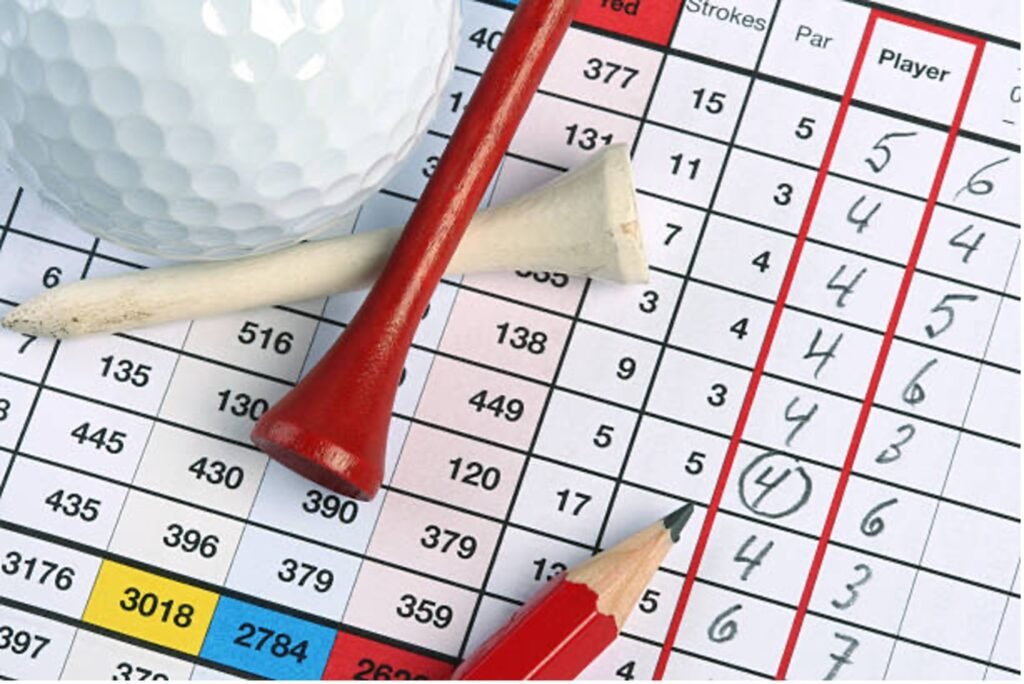How golf scoring works

A golf ball near a hole | @thomasward
Golf goes beyond the fairways and groomed greens. Understanding golf scoring is not only a question of numbers; it is the key to unlocking the complexity, difficulties, and victories that characterize the sport. The relevance of grasping golf scoring goes beyond the scorecard; it is a roadmap that leads a golfer through the process of strategy, decision-making, and mastery. Golf scoring is anchored in a set of basic principles that influence how players record and evaluate their performance on the course.
Basics of Golf Scoring

A golf scorecard |@biitli
The main objective of a golfer is to finish a round with the fewest strokes feasible. The beauty of this objective reflects the spirit of the sport, where accuracy, strategy, and talent meet to manage the obstacles of each hole and the whole course. The golfer’s ambition is not only to conquer the fairways and greens but to do so with a mastery that minimizes the effect on the scorecard.
Scoring Terminologies
A birdie is defined as completing a hole with one stroke less than par.
Eagle: A hole finished in two strokes under par.
A bogey is a hole that is accomplished in one more stroke than par.
A double bogey is when you finish a hole two strokes over par.
A triple bogey is when you finish a hole in three strokes over par.
How golf scoring works
- Every stroke taken on the golf course adds to a player’s score. From the tee shot on the first hole to the last putt on the last green, each stroke is methodically tabulated.
- Par as the Benchmark – Par reflects the normal number of strokes that a competent golfer is estimated to take to complete a hole or an entire game. The word is derived from “professional average result,” highlighting the skill level anticipated from an accomplished golfer.
- Score Relative to Par – Scores for a round or an individual hole are usually given relative to par. The connection between a golfer’s score and par determines whether he or she is under, at, or over par.
- Cumulative Scoring: The final score for a round is the sum of the points earned for each hole. For example, if a golfer finishes a round with four straight holes with scores of 4, 3, 5, and 4, their total score is 16.
- Handicaps and Strokes: Handicap systems are designed to level the playing field in tournaments with participants of varied skill levels. A golfer’s handicap is subtracted from their overall score to provide a net score that adjusts for disparities in skill.

A golf player with a club | @jopwell
What is a Par?
A par is a standard score that indicates how many strokes an experienced golfer should take to accomplish a hole or an entire game. The word “par” is an abbreviation for “professional average result,” and it refers to the degree of talent that is required of great performers. The length and difficulty of each hole, as well as characteristics like distance, hazards, and green intricacy, are used to calculate par.
Less Than Par (Birdie and Eagle)
A birdie is earned when a golfer completes a hole in one stroke less than par. When a hole is finished in two strokes fewer than par, it is considered an eagle. Birdies and eagles both show a golfer’s ability to negotiate the course accurately and are markers of excellent performance.
Making Par
Making Par is defined as completing a hole with the same number of strokes as par. Consistently hitting par is a fantastic outcome that reflects competent, error-free play.
A Bogey
A bogey happens when a golfer takes one stroke longer than par to complete a hole. When a hole is finished in two strokes more than par, it is considered a double bogey. While bogeys and double bogeys are indicators of course difficulty, they are typical for golfers of all ability levels.
Understanding Par Scoring with Birdies, Eagles, and Bogeys
- When a golfer completes a hole in one stroke less than par, this is referred to as a birdie. It’s a good result that shows competence and efficiency on the course. A par-4 hole, for example, requires three strokes to complete.
- When a golfer completes a hole in two strokes fewer than par, he or she has made an eagle. This accomplishment is often saved for longer holes, like as par-5s finished in three strokes.
- When a golfer takes one stroke more than par to finish a hole, this is referred to as a bogie. Bogeys are frequent and generally acceptable on tough holes, albeit demonstrating a reasonable effort.
- A double bogey occurs when a golfer takes two strokes longer to accomplish a hole than par. While it denotes more significant issues, it is a common stumbling point for golfers.
Stroke Play versus Match Play Strokes Scored Across All Holes:
The purpose of stroke play is to finish the round in the fewest number of strokes feasible.
Scoring Method: Throughout the round, golfers score their strokes, adding the number of strokes taken on each hole. The winner is determined at the conclusion of the round by the player or competitor with the lowest total score. It is an all-encompassing evaluation of overall play throughout all 18 holes. It is also important to be consistent: Consistency is crucial in stroke play. Each hole adds to a golfer’s final score, and rebounding from a bad hole is crucial to remaining competitive.
Match Play: Hole-by-Hole Competition with an Emphasis on Individual Hole Winning: Match play is a head-to-head battle on each course with the aim of winning more holes than the opponent.
Scoring Method: Scoring is based on the number of holes won, lost, or tied rather than total strokes. Golfers compete for specific holes as opposed to total strokes. Winner is determined by the player who wins the most holes throughout the round. The total number of strokes is inconsequential; the purpose is to win more holes than the opponent. Match play necessitates strategic considerations. Golfers may take a more aggressive or defensive position depending on the conditions of the match. The overall aim is to win a hole.
Handicap Scheme
A golf handicap is a numerical evaluation of a golfer’s ability that is used to level the playing field for players of various skill levels. It gives a methodical assessment of a golfer’s predicted round performance. Lesser handicap numbers imply a better level of playing skill, whereas higher handicap numbers indicate a lesser level of playing ability. A golfer with a handicap of 5 is seen to be more talented than one with a handicap of 15. A handicap system is necessary for fair competition among golfers of all ability levels. It modifies a player’s gross score to determine their net score, resulting in a more fair playing field for competition.
Net vs. Gross: The exact number of strokes necessary by a golfer to finish a round without making any changes is known as a gross score.
Net score: A golfer’s net score is computed by subtracting their handicap from their gross score. This adjustment indicates the player’s skill level performance.
For example, if a golfer has a handicap of 10 and completes a round with a gross score of 85, his or her net score is 75 (85 – 10 = 75). Players of varying skill levels may compete on a level playing field as a result of this.
The handicap system allows participants of differing skill levels to participate in a fair and pleasurable way. It recognizes that not all golfers play at the same level and offers a method to compensate for these disparities.
Key Scorecard Details
Player data: This scorecard area normally includes the golfer’s name, date, and course information.
Information about the hole: Each hole on the course is mentioned on the scorecard. The hole number, par, and distance are all included in this data.
Par for the Course: On occasion, the total par for the whole course is given on the scorecard, showing the sum of all individual hole pars.
Handicap Ratings: Based on the difficulty of the hole, a handicap rating is awarded to it. The handicap is used in assessing strokes given or received during match play or for computing net scores.
Score Columns: Each hole on the scorecard has its own column where golfers write their scores. Spaces in columns may be used to record strokes, putts, and other important statistics.
Cumulative Totals: The scorecard typically displays a running total for each nine holes as well as the whole 18-hole round. Golfers may use this to monitor their progress during the game.
Strokes: After each hole, golfers enter the number of strokes required to accomplish that hole in the appropriate column on their scorecard.
Putts: Some scorecards contain a separate column for putts, which allows players to tally how many putts they take on each hole.
Running Totals: Golfers calculate running totals for each nine-hole segment as well as the whole 18-hole round by adding the scores from each column.
If a golfer has a handicap, the net score may be computed by deducting the handicap from the gross score. This gives a more realistic assessment of a player’s performance in accordance to his or her ability level.
Tracking Penalty Strikes
Penalties such as out-of-bounds lost balls, water hazards, unplayable lies, and other infractions occur a lot during golf gameplay. Each penalty adds another stroke. Penalty strokes are added to the golfer’s total strokes on the hole, resulting in their overall round score. Penalty strokes may greatly influence a golfer’s score and show flaws in course management and shot selection.
Scoring Formats for Tournaments
A Summary of the Various Tournament Scoring Formats are highlighted below.
- Point System: Golfers get points on each hole depending on their scores relative to par. Points are provided for higher scores and subtracted for lower scores. The golfer’s objective is to get as many points as possible while focusing on steady, good play.
- Modified Stableford Scoring: Modified Stableford is a version of Stableford in which points are earned or lost depending on scores relative to par. However, the point system may vary from traditional Stableford scoring.
3. Four-ball and four-some formats:
Four-Ball: Each member of a two-player team plays his or her ball, and the lowest of the two scores is used to calculate the team’s score on each hole.
Foursomes: In foursomes, two team members alternate hitting the same ball. The total number of strokes taken by both players is used to calculate the team’s score.
These tournament scoring strategies provide diversity to tournaments by presenting distinct challenges and approaches that go beyond standard stroke play. Each format offers a distinct view of professional golf collaboration, consistency, and flexibility
How to Break Ties and Playoffs
Scorecard Ties in stroke play are normally broken by comparing scores on individual holes, beginning with the back nine, then the last six, three, and finally the 18th. The person who has the lowest score on these selected holes wins the tiebreaker. If the scorecard playoff results in a tie, matching cards may be utilized. Golfers compare their scores on each hole, starting with the previous hole and moving backward until the tie is broken.
In match play, sudden death may be employed, in which players continue to play holes until one of them wins the hole outright, breaking the tie. Sudden-death circumstances require a player to continue playing until he or she wins a hole.
In match-play playoffs, on the other hand, the first player to win a hole outright is named the champion. The format of the playoffs might vary, such as 18-hole playoffs or a specific number of holes.
Summary
| Par | The number of strokes required by a skilled golfer to finish a hole or a game of golf. |
| Birdie | A birdie is a hole score of one stroke under par. |
| Eagle | A hole with a score of two strokes under par. |
| Bogey | A hole in one stroke over par. |
| Double bogey | A hole score of two strokes over par. |
| Triple bogey | Three strokes over par on a hole. |
| Handicap | A handicap is a numerical assessment of a golfer's skill that is used to alter the player's score in order to make the game more fair. |
| Gross score | The total number of strokes taken during a round of golf before adjusting for handicap. |
| Net score | The adjusted score obtained after subtracting the golfer's handicap from the gross score. |
| Stableford | A scoring system in which points are granted depending on a player's hole-by-hole score relative to par. |